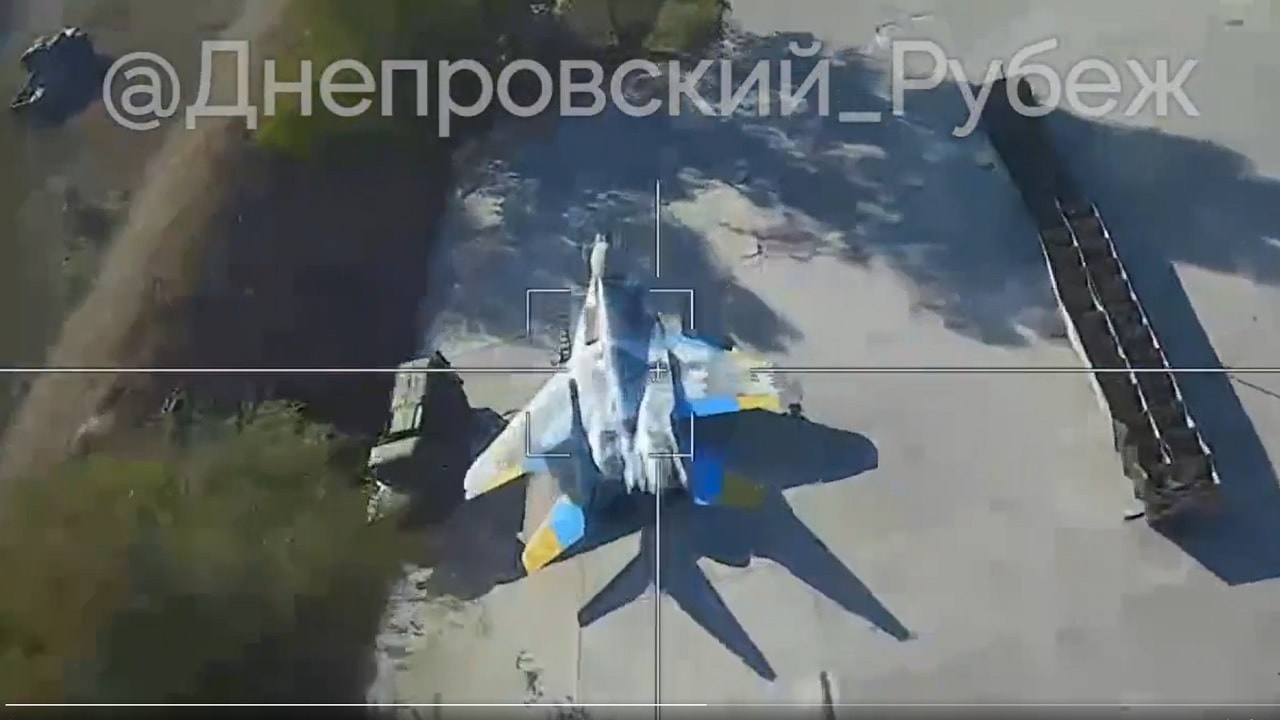Since February 2022, drone warfare has perhaps monopolized the Russian invasion of Ukraine. From smaller surveillance unmanned aerial vehicles (UAVs) to lethal suicide drones, both Kyiv and Moscow have deployed these weapons consistently to support their respective war efforts.
Initially, the Kremlin depended heavily on domestic products and the Iranian regime to supply its drone arsenal. Over the last year and a half of warfare, however, Russian forces have learned how to operate these UAVs more effectively.
MiG-29 Under Attack By Drone
This week, a Russian-launched loitering munition reportedly attacked a parked Ukrainian MiG-29 fighter aircraft. The open-source intelligence group Ukraine Weapons Tracker published the footage on Twitter, which depicts the full attack.
According to @UAWeapons, the closest Russian positions to the airfield of Kryvyi Rih are located more than 65 kilometers away. The ZALA Lancet munition is allegedly responsible for the barrage, indicating the weapon is continuing to play a significant role in Moscow’s offensive efforts.
Introducing the Lancet Munition
Unlike the Shahed family of drones supplied by Iran that Moscow often employs, the Lancet is domestically produced.
The Russia-based ZALA Aero Group manufactures the UAV for the Russian Armed Forces. Since the onset of the invasion, Russian state-linked media outlets have boasted that the Lancet is single handedly responsible for obliterating roughly half of the artillery provided to Ukraine by the U.S. and its North Atlantic Treaty Organization (NATO) allies.
While the Lancet has been widely used by Russian forces throughout the war, the drone could previously only travel up to 25 miles. The fact that the Lancet depicted in the MiG assault video could travel farther than this threshold indicates Moscow is further developing this family of UAVs.
A Forbes report noted last month that Russian propagandists claimed to possess a new Product 53 Lancet that could travel up to 45 miles.
Russian state media outlet Sputnik described the new variant as “the next step in the evolution of the Lancet—and one which, designers hope, will become nearly impossible to stop.” Now that it appears Moscow does obtain the capability to launch attacks in Ukraine from farther positions, Kyiv should rearrange some of its air bases and other military assets to ensure they can not be reached via these longer-range drones.
An Overview of the MiG-29 “Fulcrum”
Both Kyiv and Moscow have deployed the Soviet-era MiG-29 since the beginning of the invasion. The fighter was originally designed to provide a counter to America’s fourth-generation platforms including the McDonnell Douglas F-15 Eagle and the General Dynamics F-16 Fighting Falcon and has been designated by NATO as “Fulcrum”.
With a maximum speed of Mach 2.25 (times the speed of sound), the “Fulcrum” fighter met the requirements set out by the USSR’s General Staff in the late 1960’s.
The jet can carry a singular Gryazev Shipunov GSh-30-1 30mm autocannon, in addition to nearly 9,000 pounds of ordnance like the AA-10 Alamo and AA-8 Aphid.
The Biden administration gave NATO members the green light to supply Kyiv with more advanced fourth-generation fighters like the F-16 earlier this year. Ukrainian forces must consider the placement of any new fighters in light of Moscow’s growing UAV capabilities.
#Ukraine: A Ukrainian MiG-29 fighter aircraft was damaged by a Russian Lancet loitering munition at the airfield of Kryvyi Rih.
The closest Russian positions are located more than 65 kilometers away. pic.twitter.com/2plF7i6aMH
— ???????? Ukraine Weapons Tracker (@UAWeapons) September 19, 2023
Maya Carlin, a Senior Editor for 19FortyFive, is an analyst with the Center for Security Policy and a former Anna Sobol Levy Fellow at IDC Herzliya in Israel. She has by-lines in many publications, including The National Interest, Jerusalem Post, and Times of Israel. You can follow her on Twitter: @MayaCarlin.

